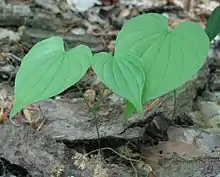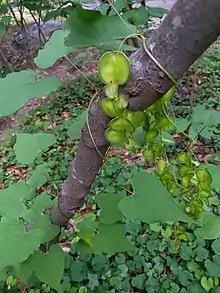Dioscorea villosa
Dioscorea villosa is a species of twining tuberous vine which is native to eastern North America. It is commonly known as wild yam, colic root, rheumatism root, devil's bones, and fourleaf yam.[2] It is common and widespread in a range stretching from Texas and Florida north to Minnesota, Ontario and Massachusetts.[1][3][4][5] It is currently on the United Plant Savers "At Risk" list. UpS is an organization concerned with the preservation of endangered medicinal plants on the territory of North America.[6]
| Dioscorea villosa | |
|---|---|
 | |
| Scientific classification | |
| Kingdom: | Plantae |
| Clade: | Tracheophytes |
| Clade: | Angiosperms |
| Clade: | Monocots |
| Order: | Dioscoreales |
| Family: | Dioscoreaceae |
| Genus: | Dioscorea |
| Species: | D. villosa |
| Binomial name | |
| Dioscorea villosa | |
| Synonyms[1] | |
| |
Botany
Dioscorea villosa is, according to the Flora of North America, quite variable in shape across its range.[7] It ranges from a small vine with winged stems, tightly packed groups of flowers, variably hairy leaves all the way up to large vines with unwinged stems, large, smooth leaves, and widely spread sprays of flowers. It always has rhizomes spreading underground that can be branched or not.
Chemistry
Dioscorea villosa contains diosgenin, which despite claims is not a phytoestrogen and does not interact with estrogen receptors.[8] Other steroidal saponins are also found in the plant.
Medical Use
Some of the English common names of this plant reflect its use in Native American and other traditional medicines.[9] In traditional Russian herbal medicine, saponin extracts from the roots of various varieties of wild yam are thought to be an anticoagulant, antisclerotic, antispasmodic, cholagogue, depurative, diaphoretic, diuretic and a vasodilator.[10]
There is little modern clinical research on Dioscorea villosa, and the one study of a wild yam-containing cream for menopausal symptoms failed to find any value from this therapy.[11] According to the American Cancer Society, there is no evidence to support wild yam or diosgenin being either safe or effective in humans.[12]


References
- Kew World Checklist of Selected Plant Families
- Gotfredsen, Erik (16 Dec 2018). "Liber Herbarum II". Retrieved 27 Dec 2018.
- Flora of North America
- Govaerts, R., Wilkin, P. & Saunders, R.M.K. (2007). World Checklist of Dioscoreales. Yams and their allies: 1-65. The Board of Trustees of the Royal Botanic Gardens, Kew.
- Biota of North America Program, 2013 county distribution map
- "United Plant Savers". 1 July 2018. Retrieved 27 Dec 2018.
- "Flora of North America". 2008. Retrieved 27 Dec 2018.
- Medigović I, Ristić N, Živanović J, Šošić-Jurjević B, Filipović B, Milošević V, Nestorović N (2014). "Diosgenin does not express estrogenic activity: A uterotrophic assay". Can J Physiol Pharmacol. 92 (4): 292–8. doi:10.1139/cjpp-2013-0419. PMID 24708211..
- Austin, DF (2004). Florida Ethnobotany. Boca Raton: CRC Press. p. 267. ISBN 9780849323324.
- Zevin, Igor Vilevich. A Russian Herbal. 1997. Rochester, Vermont: Healing Arts Press. p.146-47.
- Geller SE, Studee L (2005). "Botanical and dietary supplements for menopausal symptoms: What works, what doesn't". J Womens Health (Larchmt). 14 (7): 634–49. doi:10.1089/jwh.2005.14.634. PMC 1764641. PMID 16181020..
- "Wild Yam". American Cancer Society. November 2008. Retrieved 21 September 2013.
Further reading
- http://www.nlm.nih.gov/medlineplus/druginfo/natural/970.html
- Eagon PK, Elm MS, Hunter DS, et al. Medicinal herbs: modulation of estrogen action. Era of Hope Mtg, Dept Defense; Breast Cancer Res Prog, Atlanta, GA 2000;Jun 8-11.
External links
| Wikimedia Commons has media related to Dioscorea villosa. |
| Wikispecies has information related to Dioscorea villosa. |